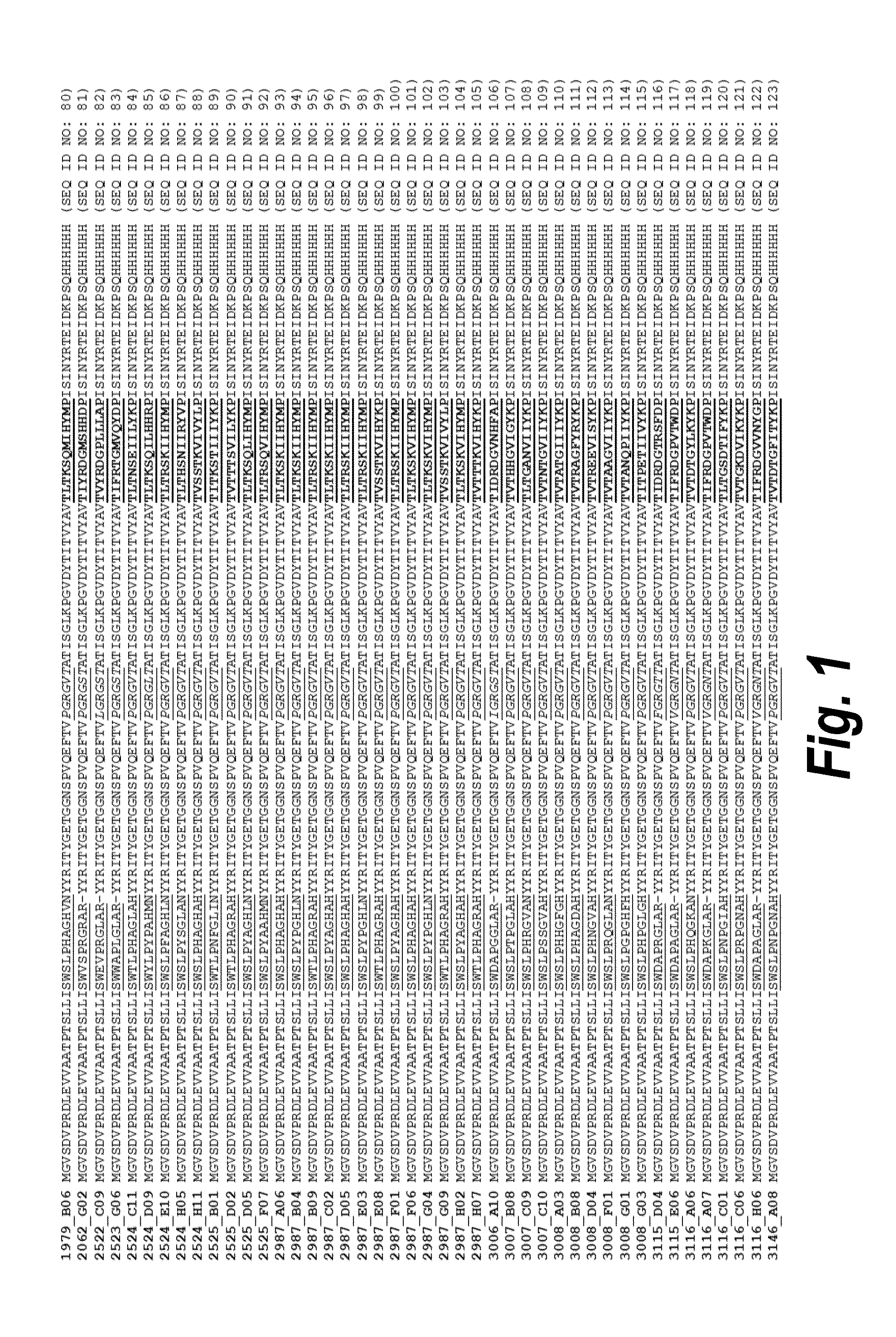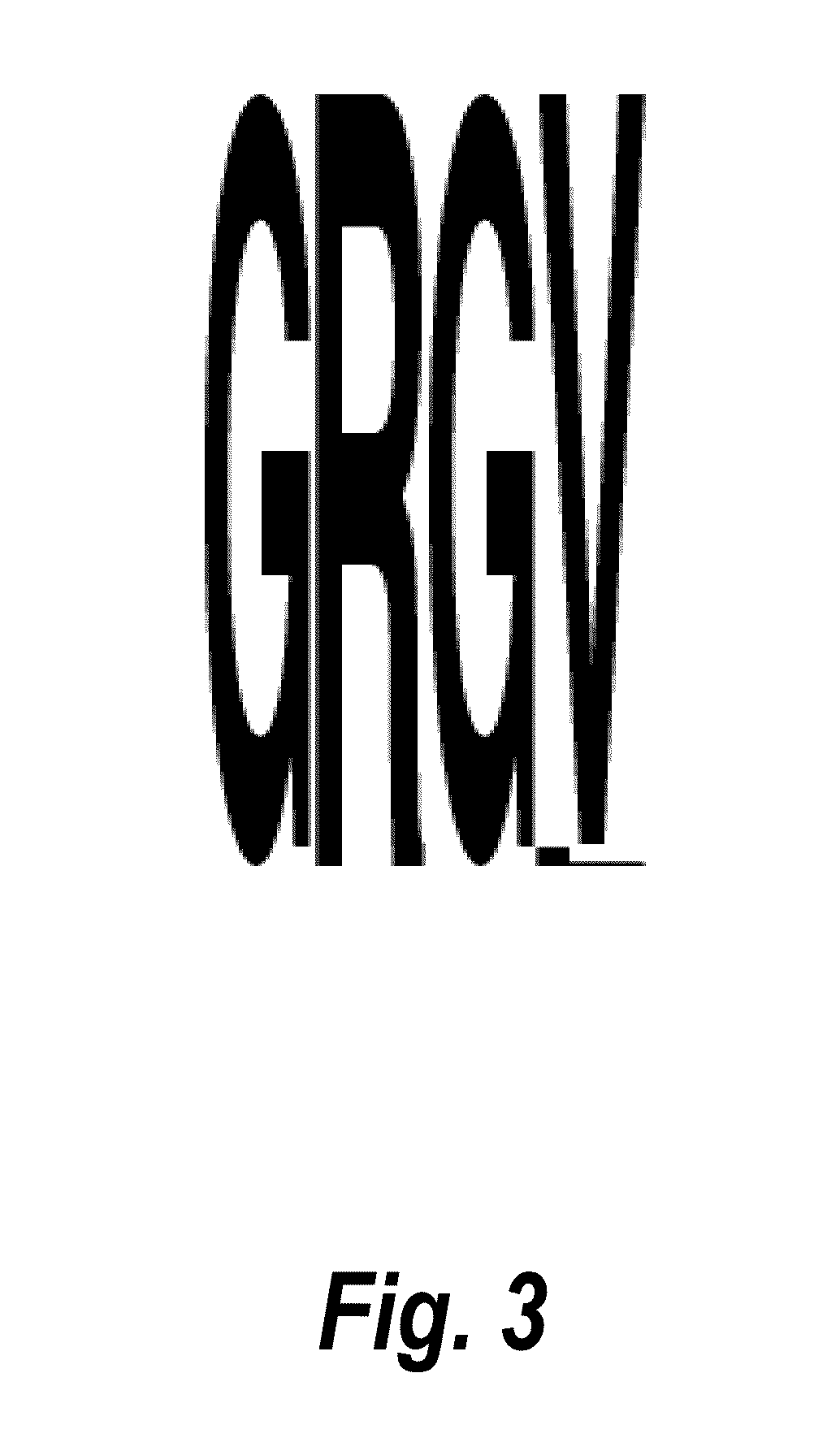Fibronectin based scaffold domain proteins that bind to myostatin
a scaffold domain and protein technology, applied in the direction of peptide/protein ingredients, fusion polypeptides, depsipeptides, etc., can solve problems such as muscle loss, and achieve the effects of increasing muscle mass, increasing muscle cell number, and increasing muscle cell siz
- Summary
- Abstract
- Description
- Claims
- Application Information
AI Technical Summary
Benefits of technology
Problems solved by technology
Method used
Image
Examples
example 1
Protein Production
High Throughput Protein Production (HTPP)
[0336]Selected binders cloned into the PET9d vector upstream of a HIS6tag and transformed into E. coli BL21 DE3 plysS cells were inoculated in 5 ml LB medium containing 50 μg / mL kanamycin in a 24-well format and grown at 37° C. overnight. Fresh 5 ml LB medium (50 μg / mL kanamycin) cultures were prepared for inducible expression by aspiration of 200 μl from the overnight culture and dispensing it into the appropriate well. The cultures were grown at 37° C. until A600 0.6-0.9. After induction with 1 mM isopropyl-β-thiogalactoside (IPTG), the culture was expressed for 6 hours at 30° C. and harvested by centrifugation for 10 minutes at 2750 g at 4° C.
[0337]Cell pellets (in 24-well format) were lysed by resuspension in 450 μl of Lysis buffer (50 mM NaH2PO4, 0.5M NaCl, 1× Complete™ Protease Inhibitor Cocktail-EDTA free (Roche), 1 mM PMSF, 10 mM CHAPS, 40 mM imidazole, 1 mg / ml lysozyme, 30 μg / ml DNAse, 2 μg / ml aprotonin, pH 8.0) and...
example 2
Biophysical Assessment of Anti-Myostatin Proteins
[0358]Size Exclusion Chromatography: Standard size exclusion chromatography (SEC) was performed on candidate Adnectins resulting from the midscale process. SEC of midscaled material was performed using a Superdex 200 10 / 30 or on a Superdex 75 10 / 30 column (GE Healthcare) on an Agilent 1100 or 1200 HPLC system with UV detection at A214 nm and A280 nm and with fluorescence detection (excitation 280 nm, emission 350 nm). A buffer of 100 mM sodium sulfate / 100 mM sodium phosphate / 150 mM sodium chloride, pH 6.8 was used at the appropriate flow rate for the SEC column employed. Gel filtration standards (BioRad Laboratories, Hercules, Calif.) were used for molecular weight calibration. The results of the SEC on midscaled purified Adnectins showed predominantly monomeric adnectin and elution in the approximate range of 10 kDa vs. globular Gel Filtration standards (BioRad) as shown in Tables 9 and 10.
[0359]Thermostability: Thermal Scanning Fluo...
example 3
Cell-Based Luciferase Assay
[0360]A luciferase reporter plasmid, Activin-Responsive Element (ARE)-luc, was generated by ligating nine repeats of the ARE in tandem to the firefly luciferase reporter. The plasmid was transiently transfected into HepG2 cells. Plasmid pGL4.74[hRluc / TK] was co-transfected to normalize for transfection efficiency. 10,000 cells were plated per well in a 96-well plate. When a protein such as myostatin, activin, or BMP-11, is added to cells and binds to its cognate receptor, downstream SMAD signaling is triggered, leading to binding of a phosphorylated SMAD complex to the ARE. The amount of, e.g., myostatin, exposed to the cells is directly proportional to the amount of luciferase protein produced and, consequently, luciferase activity measured. When a myostatin antagonist (e.g., an anti-myostatin Adnectin) is added concurrently with myostatin to the cells, activation of the ARE decreases, leading to a decreased luciferase production and activity.
[0361]In thi...
PUM
 Login to View More
Login to View More Abstract
Description
Claims
Application Information
 Login to View More
Login to View More - R&D
- Intellectual Property
- Life Sciences
- Materials
- Tech Scout
- Unparalleled Data Quality
- Higher Quality Content
- 60% Fewer Hallucinations
Browse by: Latest US Patents, China's latest patents, Technical Efficacy Thesaurus, Application Domain, Technology Topic, Popular Technical Reports.
© 2025 PatSnap. All rights reserved.Legal|Privacy policy|Modern Slavery Act Transparency Statement|Sitemap|About US| Contact US: help@patsnap.com



